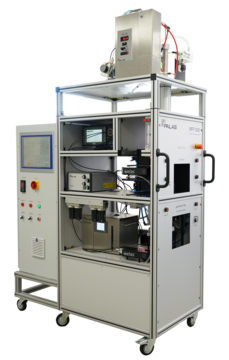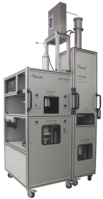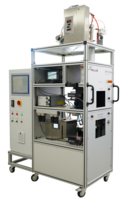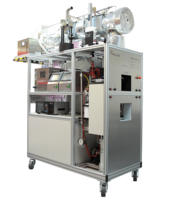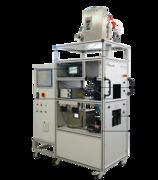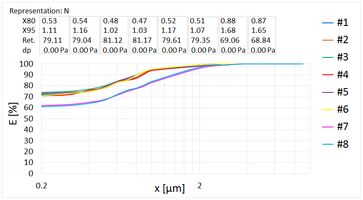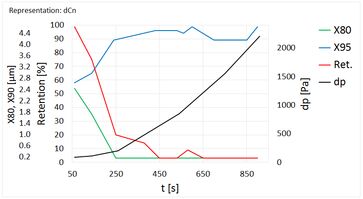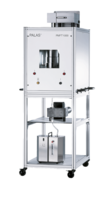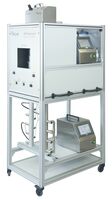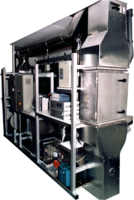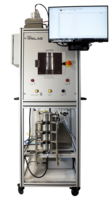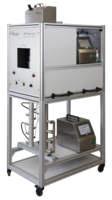MFP 3000
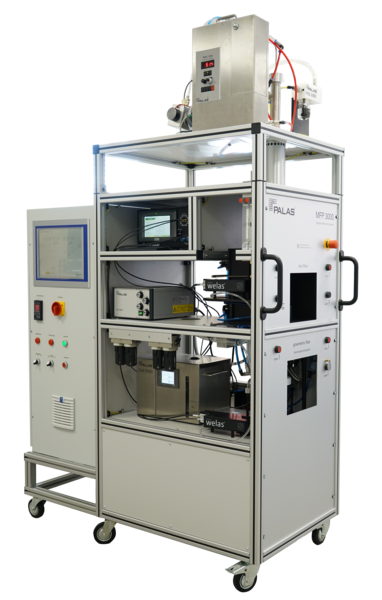
The MFP filter test rig is a modular filter testing system for flat filter media and small mini-filters.
This enables you to determine the
- pressure loss curve on the medium without a dust coating,
- fraction separation efficiency, or
- burden and fraction separation efficiency during application of the burden
- and the gravimetric separation efficiency
within shortest times – reliably and therefore cost-effectively.
The MFP 3000 operates in suction mode. This ensures a particularly uniform formation of the dust cake even at high inflow speeds.
With the aid of the light scattering spectrometer Promo® 3000, clear and reliable determination of the aerosol concentration and the particle size and therefore a clear determination of the fraction separation efficiency can be ensured. In addition, use of the welas® digital 3000 or Promo® 3000 with two sensors for virtually simultaneous particle measurement offers the following advantages:
- Fully-automatic measurement of fraction separation efficiency
- Use of the testing system for very high and very low aerosol concentrations
The largely automated setup of the test sequence in conjunction with the clearly defined individual components and the individually adjustable sequence programs of the filter test software FTControl combine to deliver the high reliability of our measurement results.
Variants
More alternatives
Norms and certificates
National and international standards
ISO 5011 ISO/TS 19713 DIN 71460 ISO 11155-1 EN 779 ASHARE 52.2 ISO 16890
Operation principle
Modular filter media test rig
Fig. 1: MFP 3000
1. Variable aerosol generation: Thanks to the use of different dispersers for dusts, KCl/ NaCl, DEHS etc.; shortened measurement times are possible e.g. through increased dust concentration
2. Corona discharge (optional): Adjustable ion stream for different mass flows. Mixed air, adjustable for inflow speeds from 0.05 to 1 m/s. Optional: Transient inflow.
3. Light scattering spectrometer Promo® 3000 for clear particle measurements in high concentrations of up to 5000 mg/m3 (SAE Fine) and low concentrations for the determination of the initial fraction separation efficiency
4. Mobile pneumatic filter holder for fast removal and loading of the test rig.
5. Gravimetric filter holder for simple and fast evaluation of the gravimetric separation efficiency.
6. Raw gas sensor
7. Clean gas sensor
The MFP 3000 has an integrated mass flow controller that it uses to control the volume flow. The volume flow rates are automatically monitored and controlled by the FTControl filter test software. The data from the integrated sensors – such as the volume flow, temperature, relative humidity and differential pressure at the filter – are also recorded automatically during the filter test.
Fig. 2: Example: Comparison of fraction separation efficiencies
- Fully-automated measurement of the fraction separation efficiency
- Clear demonstration of the separation efficiency of your filter medium throughout the entire measurement range from 0.2 to 40 µm with the Promo® system
- Highest measurement reproducibility and repeatability highlight even fine differences in the separation efficiency
- Short measurement times of around 2 minutes per separation efficiency measurement thanks to optimized aerosol application
- Simple comparison of separation efficiency curves, calculation of mean values also possible
The vertical layout allows even large particles (up to 40 µm) to make their way onto the filter medium. On the raw and clean gas side, isokinetic sampling probes are provided for the raw and clean gas sensor.
Fig.34: Example: Hold time measurement
- Performance of measurements of the fraction separation efficiency during dust application; pressure loss or measurement time can be pre-selected as the abort criterion
- Pre-selectable burden application steps in relation to pressure loss or time
- Gravimetric determination of the separation efficiency
- Determination and representation of the pressure loss curve and retention curve in diagram and table form. The representation of the particle diameters at 80 % and 95 % separation efficiency provides additional information.
- Comparison of the fraction separation efficiencies during the different burdening steps
- Shortening of the measurement times, e.g. through increased aerosol concentration
Benefits
Your special advantages
- Virtually simultaneous particle measurement in the raw gas and clean gas
- Particle size measurements from 0.2 – 40 µm
- Measurement of Cn max= 106 particles/cm3 without dilution
- Internationally comparable measurement results
- Widespread distribution of the measurement system
- High reproducibility of the testing method
- Easy use of different test aerosols, e.g. SAE Fine and Coarse, NaCl/KCl, DEHS
- Highest raw gas concentrations of up to > 1000 mg/m3 (ISO Fine) or > 5000 mg/m3 (ISO Coarse) with measurement of the fraction separation efficiency for burden tests
- Flexible filter test software FTControl
- Sequence programs for pressure loss measurements, measurements of fraction separation efficiency and burden measurements
- Easy to operate, even untrained personnel can be instructed quickly in the use of the equipment
- Short set-up times
- Cleaning and calibration can be performed autonomously by the customer
- Easy use of the measurement technology components – even in other applications
- Mobile setup, easy to move on castors
- Reliable operation
- Validation of the clear function of individual components and the overall system during pre-delivery acceptance testing and upon delivery
- Low-maintenance
- The unit will reduce your operating costs
Applications
Individual solutions for various industries
- For filter media and small filter elements
- Product development and during production monitoring
- Testing based on ISO 11155-1 / DIN 71460-1 (cabin air filters)
- Testing based on ISO 5011 (engine pre-air filters)
- Testing based on ISO 16890 (room air filters)
- Other standards in various versions
- Fully automatic measurement of the fractional efficiency, the pressure drop curve, the dust holding capacity and the gravimetrical efficiency
- International comparable results due to the high distribution of the system
Technical features
In detail
- Aerosols
- Dusts (e.g., SAE dusts), salts (e.g., NaCl, KCl), liquid aerosols (e.g., DEHS)
- Test area of the medium
- 100 cm2
- Measurement range (size)
- 0.2 – 40 µm
- Measurement range (mass)
- Up to 1,000 mg/m³ (depending on the version)
- Volume flow
- 1 – 35 m3/h - suction mode
- Differential pressure measurement
- 0 – 1,200 Pa selectable, 0 – 2,500 Pa selectable, 0 – 5,000 Pa selectable
- Inflow velocity
- 5 cm/s – 1 m/s (others on request)
- Compressed air supply
- 6 – 8 bar
- Dimensions
- 2.500 • 680 • 1.550 mm (H • B • T)
